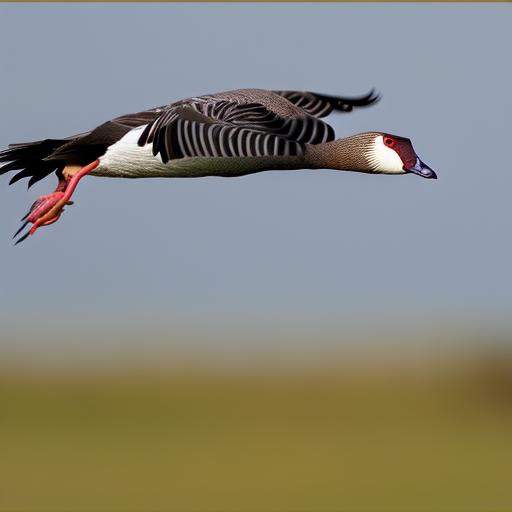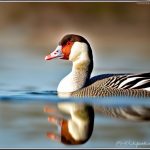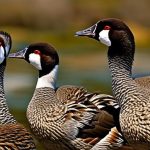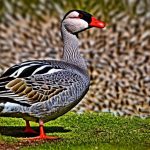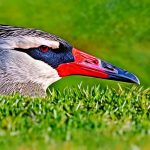Geese are social birds that are known for their strong family bonds and protective nature. They are highly territorial and will defend their nesting sites and offspring from perceived threats. Understanding the behavior of geese is crucial for creating a safe and comfortable environment for them. Geese communicate through honking, body language, and physical displays. They are highly vocal and will use their honking to alert other members of the flock to potential dangers. Geese are also known for their aggressive behavior, especially during the breeding season when they are protecting their nests and young goslings. It’s important to recognize the signs of aggression in geese, such as hissing, wing flapping, and charging, in order to avoid confrontations and ensure the safety of both the geese and humans.
Geese are also migratory birds, and their behavior can be influenced by seasonal changes and environmental factors. During the breeding season, geese will become more territorial and aggressive as they defend their nesting sites. Understanding these natural behaviors can help in creating a safe and comfortable environment for geese, as well as in implementing effective deterrents to prevent conflicts. By understanding the behavior of geese, you can better anticipate their needs and provide them with a suitable living space that meets their natural instincts and behaviors.
Key Takeaways
- Geese are social animals and exhibit strong bonding behaviors with their flock.
- Providing a safe and comfortable environment is crucial for the well-being of geese.
- Geese require access to clean water and a balanced diet to thrive.
- Physical barriers such as fencing can help keep geese away from unwanted areas.
- Training and bonding with geese can help establish a positive relationship and reduce aggressive behavior.
- Visual and auditory deterrents can be effective in deterring geese from specific areas.
- Seeking professional help from a veterinarian or animal behaviorist may be necessary for addressing complex behavioral issues.
Creating a Safe and Comfortable Environment
Creating a safe and comfortable environment for geese is essential for their well-being and overall health. Geese require access to open water for swimming, grazing areas for foraging, and sheltered spaces for nesting and resting. When designing a living space for geese, it’s important to consider their natural behaviors and instincts. Providing a pond or access to clean water is crucial for geese, as they are waterfowl and enjoy swimming and bathing. Additionally, grazing areas with fresh grass and vegetation are essential for their diet and overall health.
Shelter is also important for geese, especially during the nesting season. Providing nesting boxes or sheltered areas can help create a safe space for geese to lay their eggs and raise their young. It’s important to ensure that the living space is free from potential hazards such as predators, toxic plants, or sharp objects that could harm the geese. By creating a safe and comfortable environment for geese, you can help reduce stress and aggression, as well as promote their natural behaviors and instincts.
Providing Adequate Food and Water
Providing adequate food and water is essential for the health and well-being of geese. Geese are herbivores and primarily feed on grasses, grains, and aquatic plants. It’s important to provide a balanced diet that meets their nutritional needs, including access to fresh grass, grains, and water plants. Additionally, supplementing their diet with commercial waterfowl feed can help ensure that they receive all the necessary vitamins and minerals.
Access to clean water is crucial for geese, as they require it for drinking, bathing, and preening. Providing a pond or shallow water source can help meet their natural instincts and behaviors. It’s important to regularly clean and maintain the water source to prevent the spread of diseases and ensure its quality. By providing adequate food and water, you can help promote the health and well-being of your geese while also reducing potential conflicts and aggressive behaviors.
Implementing Physical Barriers
Implementing physical barriers can help prevent conflicts between geese and humans, as well as protect sensitive areas from damage caused by grazing or nesting geese. Fencing can be an effective way to create boundaries and prevent geese from accessing certain areas. It’s important to use materials that are durable and tall enough to prevent geese from flying over or reaching through the fence.
Additionally, using landscaping features such as hedges or shrubs can help create natural barriers that deter geese from entering specific areas. These features can also provide shelter and nesting sites for geese, which can help reduce their desire to nest in unwanted areas. By implementing physical barriers, you can help create a safe and comfortable environment for both geese and humans while also protecting sensitive areas from potential damage.
Training and Bonding with Your Geese
Training and bonding with your geese can help establish trust and reduce aggressive behaviors. Geese are intelligent birds that can be trained to respond to commands and cues. Positive reinforcement techniques such as treats or praise can be used to encourage desired behaviors such as coming when called or staying in designated areas.
Bonding with your geese through regular interaction can also help build trust and reduce fear-based aggression. Spending time with your geese, talking to them, and providing gentle physical contact can help them become more comfortable around humans. Building a strong bond with your geese can help reduce stress and aggression while also promoting positive behaviors.
Using Visual and Auditory Deterrents

Using visual and auditory deterrents can help discourage geese from entering unwanted areas or causing conflicts. Visual deterrents such as scarecrows, reflective tape, or predator decoys can create a sense of danger that deters geese from approaching. These deterrents can be effective in protecting sensitive areas such as gardens or ponds from grazing or nesting geese.
Auditory deterrents such as ultrasonic devices or noise makers can also be used to create a hostile environment that discourages geese from staying in specific areas. These deterrents can help reduce stress and aggression while also preventing potential conflicts between geese and humans.
Seeking Professional Help if Necessary
If you are experiencing persistent issues with aggressive geese or are unsure how to effectively manage their behavior, seeking professional help may be necessary. Consulting with a wildlife expert or animal behaviorist can provide valuable insights and guidance on how to address the behavior of geese in a humane and effective manner.
Professional help can also be beneficial in developing a comprehensive management plan that addresses the specific needs of your geese while also considering the safety and well-being of humans. By seeking professional help, you can gain access to specialized knowledge and resources that can help you better understand and manage the behavior of geese in your environment.
In conclusion, understanding the behavior of geese is crucial for creating a safe and comfortable environment that meets their natural instincts and behaviors. By providing adequate food and water, implementing physical barriers, training and bonding with your geese, using visual and auditory deterrents, and seeking professional help if necessary, you can effectively manage the behavior of geese while promoting their well-being and reducing potential conflicts with humans.
Sure, here’s the paragraph with the related article included as an tag:
If you’re looking for ways to keep geese from flying away, you may also be interested in learning about how to keep your quails safe and comfortable while they sit on their eggs. This article on poultrywizard.com provides valuable insights into the behavior of quails during the incubation process and offers tips for creating an optimal environment for successful hatching. Understanding the nesting habits of different poultry species can help you enhance your overall approach to managing your flock.
FAQs
What are some methods to keep geese from flying away?
Some methods to keep geese from flying away include clipping their flight feathers, using deterrents such as visual scare devices or noise makers, and providing a secure and comfortable environment to discourage them from leaving.
Is it legal to clip a goose’s flight feathers?
In many places, it is legal to clip a goose’s flight feathers as long as it is done in a humane and non-invasive manner. However, it is important to check local regulations and consult with a veterinarian or wildlife expert before attempting to clip a goose’s flight feathers.
What are some visual scare devices that can be used to keep geese from flying away?
Visual scare devices such as predator decoys, reflective tape, and scarecrows can be effective in deterring geese from flying away. These devices create a sense of danger and make the area less appealing for the geese to stay.
Are noise makers effective in keeping geese from flying away?
Noise makers such as propane cannons, electronic bird distress calls, and ultrasonic devices can be effective in deterring geese from flying away. The sudden and unexpected noises disrupt their sense of security and encourage them to find a quieter location.
How can providing a secure and comfortable environment help keep geese from flying away?
Providing a secure and comfortable environment for geese, such as access to food, water, and shelter, can make them less likely to fly away in search of better conditions. Creating a welcoming and safe space can encourage geese to stay in the area.
Meet Walter, the feathered-friend fanatic of Florida! Nestled in the sunshine state, Walter struts through life with his feathered companions, clucking his way to happiness. With a coop that’s fancier than a five-star hotel, he’s the Don Juan of the chicken world. When he’s not teaching his hens to do the cha-cha, you’ll find him in a heated debate with his prized rooster, Sir Clucks-a-Lot. Walter’s poultry passion is no yolk; he’s the sunny-side-up guy you never knew you needed in your flock of friends!

